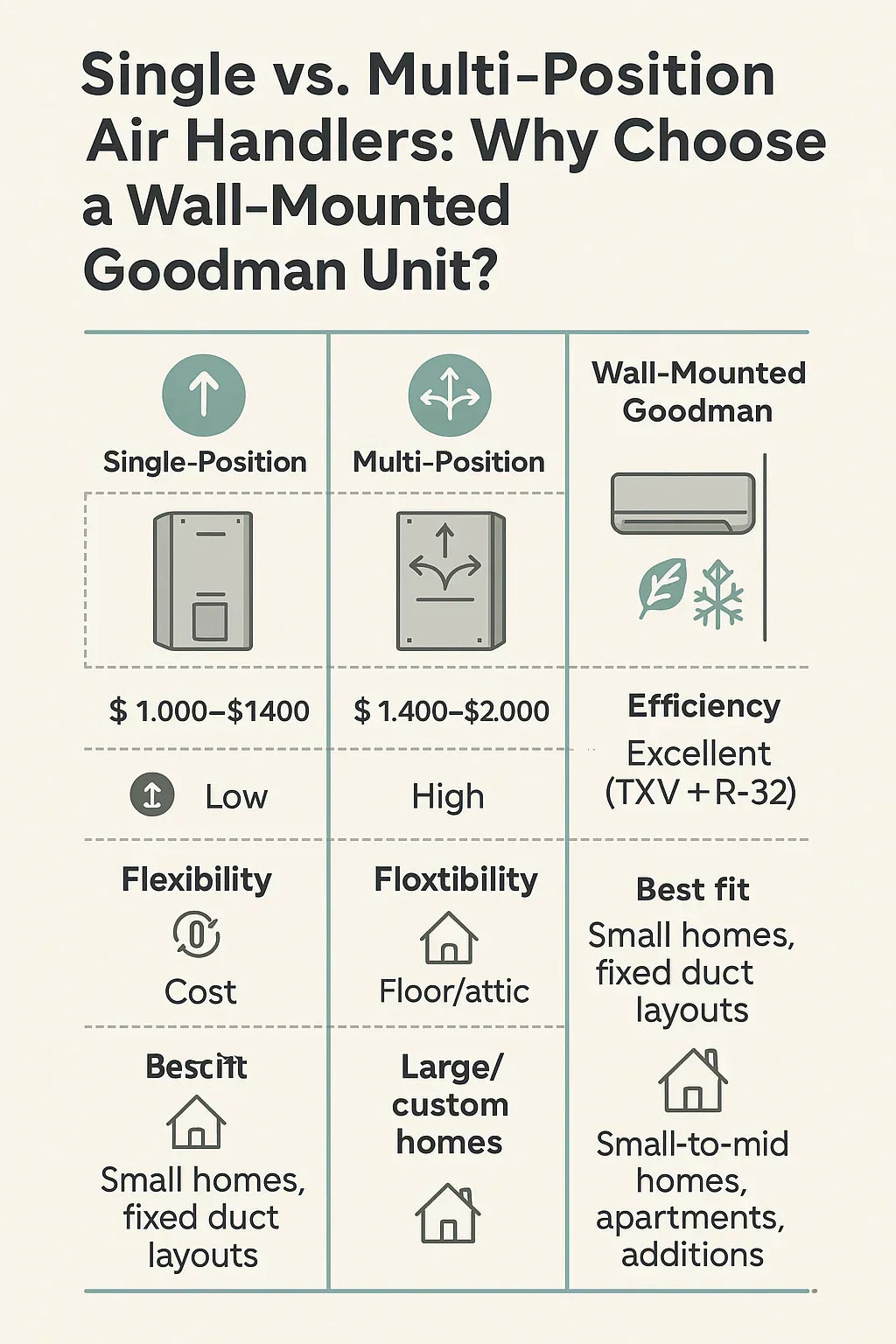When you’re shopping for a new HVAC system, you’ll quickly discover that air handlers come in different orientations: single-position, multi-position, and wall-mounted. And if you’re like most homeowners, your first thought is:
👉 “What’s the difference, and which one is right for my house?”
That’s where I come in. I’ve been through the HVAC maze myself, and I’ll help you break down the jargon into plain English.
2 Ton Wall Mounted Goodman Air Handler - AWST24SU1305
In this guide, we’ll cover:
-
🌀 What air handlers actually do in your system
-
🔄 How single-position air handlers work
-
🔧 Why multi-position air handlers are more flexible
-
🏠 Where wall-mounted units shine
-
🌡️ How Goodman’s wall-mounted R-32 model stacks up
-
⚖️ Side-by-side comparison chart
-
👩🔧 Real-world Samantha homeowner examples
-
✅ My final recommendation
🌀 What Is an Air Handler, Anyway?
Before diving into types, let’s clarify what an air handler does.
Think of it as the indoor half of your HVAC system:
-
Contains the blower fan that pushes air through ducts
-
Houses the evaporator coil that conditions the air (cools in summer, warms in winter with heat strips)
-
Works in tandem with your outdoor condenser or heat pump
Without the air handler, your system is just a fancy outdoor box. It’s the part that distributes comfort throughout your home.
👉 The U.S. Department of Energy explains that proper air handler sizing and placement are key to maximizing efficiency and airflow.
🔄 Single-Position Air Handlers
A single-position air handler is designed for one fixed orientation:
-
Upflow (air enters from bottom, exits top)
-
Downflow (air enters from top, exits bottom)
-
Horizontal (air flows sideways, often in attics or crawl spaces)
Pros:
-
Simpler design = lower upfront cost
-
Ideal for straightforward duct setups
-
Fewer moving parts = fewer installation mistakes
Cons:
-
Limited flexibility—if your ductwork changes, the handler may not fit
-
Less adaptable for renovations or expansions
-
Can take up more floor space than wall-mounted units
👉 According to HVAC.com, single-position units are common in smaller homes and mobile homes where ductwork is predictable.
🔧 Multi-Position Air Handlers
A multi-position air handler can be installed in different orientations—upflow, downflow, or horizontal—depending on your ductwork layout.
Pros:
-
Extremely flexible for installers
-
Great for larger homes or homes with unusual layouts
-
Reduces the need to rework duct systems during upgrades
Cons:
-
More expensive than single-position units
-
Slightly more complex installation
-
Still requires floor or attic space
👉 The Air Conditioning Contractors of America (ACCA) recommends multi-position handlers for homes with unique floorplans or when homeowners anticipate future renovations.
🏠 Wall-Mounted Air Handlers
Here’s where things get interesting. A wall-mounted air handler—like the Goodman 2 Ton R-32 Compatible Wall-Mounted Air Handler with 5 kW Heater—is designed to mount directly to a wall, not sit on the floor or attic joists.
Pros:
-
Space-saving: Perfect for closets, hallways, or apartments
-
Easier service access: Mounted at working height
-
Cleaner look: No big box in the attic or basement
-
Factory-built TXV & heater: Integrated features reduce installation time
Cons:
-
Not as flexible for large custom duct systems
-
May not handle very large homes (above ~1,400–1,600 sq. ft.)
👉 Wall-mounted units are especially valuable in smaller homes, additions, and apartments where square footage is at a premium.
🌡️ Why Goodman’s Wall-Mounted R-32 Unit Stands Out
The Goodman AWST24SU1305 isn’t just wall-mounted—it comes with smart features built in:
-
✅ R-32 compatibility: Meets 2025 refrigerant standards for lower environmental impact
-
✅ Built-in TXV: Regulates refrigerant flow for higher efficiency and comfort (Energy Star notes TXVs improve humidity control and reduce energy waste)
-
✅ 5 kW electric heater: Provides backup warmth in winter without oversizing
-
✅ Compact cabinet (20.2” wide): Fits tight spaces easily
This combination makes it future-proof, efficient, and space-friendly.
⚖️ Comparison: Single vs. Multi vs. Wall-Mounted
| Feature | Single-Position | Multi-Position | Wall-Mounted Goodman |
|---|---|---|---|
| Cost | $1,000–$1,400 | $1,400–$2,000 | $1,250–$1,800 |
| Flexibility | Low | High | Medium |
| Space Needs | Floor/attic | Floor/attic | Wall-mounted (small footprint) |
| Efficiency | Good | Very good | Excellent (TXV + R-32) |
| Best Fit | Small homes, fixed duct layouts | Large/custom homes | Small-to-mid homes, apartments, additions |
👩🔧 Samantha’s Real-World Examples
Example 1: Cape Cod Homeowner (Single-Position)
A family in Massachusetts installed a single-position upflow handler in their basement. Perfect for their simple duct setup—but when they renovated the upstairs, ductwork changes meant they eventually needed a new unit.
Example 2: Texas Ranch (Multi-Position)
A homeowner in Dallas chose a multi-position air handler for their sprawling ranch. The flexible design allowed the contractor to set it up as a downflow, fitting their attic ducts perfectly.
Example 3: Portland Apartment (Wall-Mounted Goodman)
A couple in Oregon installed a Goodman wall-mounted unit in their 1,200 sq. ft. apartment. It fit neatly into a closet, saved floor space, and the built-in 5 kW heater provided just enough warmth during chilly winters.
✅ Final Takeaways
-
Single-position air handlers are simple and cost-effective—but limited.
-
Multi-position handlers are flexible and great for complex homes—but pricier.
-
Wall-mounted Goodman units offer the best of both worlds for small-to-mid homes, with built-in efficiency features and space savings.
👉 If your home is 1,000–1,400 sq. ft., well-insulated, and you want a compact, efficient, and future-ready solution, a Goodman wall-mounted R-32 unit is the smart choice.
In the next topic we will know more about: Installation Guide: What Samantha Learned Putting in a 2 Ton Goodman Wall-Mounted Air Handler







